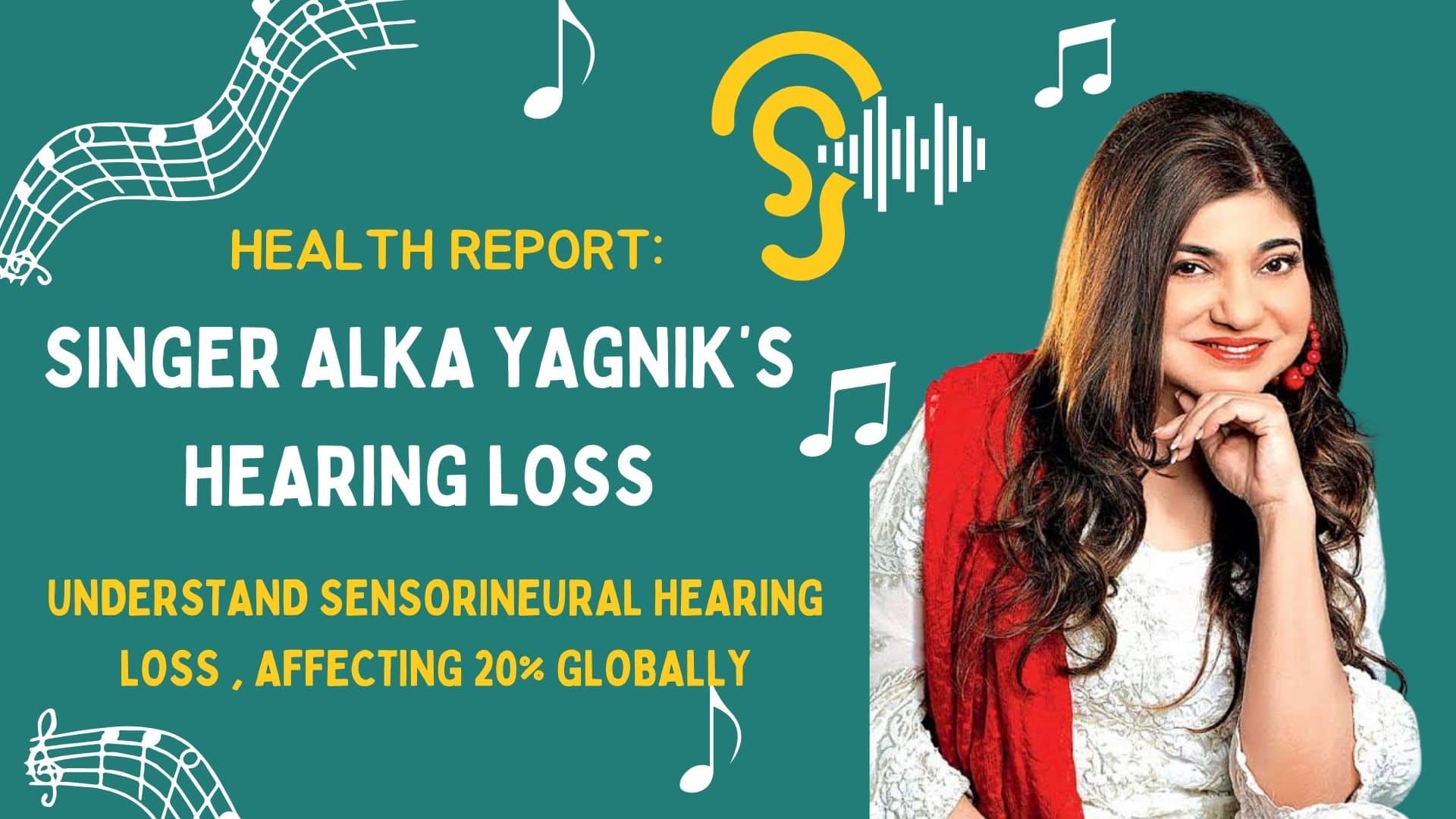Report : Alka Yagnik Hearing loss : Affecting 20% globally – Understanding Sensorineural Hearing Loss
Renowned playback singer Alka Yagnik, known for her melodious renditions of songs like “Agar Tum Saath Ho,” “Dil Ne Yeh Kaha Hai Dil Se,” and “Pehli Pehli Baar Mohabbat Ki Hai,” has recently revealed that she can no longer hear music.
The artist, who has enchanted millions with her voice, has been diagnosed with a rare condition called sensorineural hearing loss.
Sensorineural hearing loss, sometimes referred to as sudden deafness, is a condition where hearing ability deteriorates rapidly.
Typically, it affects one ear, but in some cases, both ears may lose hearing capacity. The onset can be abrupt or gradual.
In this health report, we’ll explore: ( Report : Alka Yagnik Hearing loss : Affecting 20% globally )
- The causes and timing of sensorineural hearing loss
- Early warning signs to watch for
- Safe exposure limits for various noise levels
Alka Yagnik’s Revelation:
After a prolonged absence from social media and public appearances, Yagnik addressed her fans’ concerns through an Instagram post. She advised people to avoid excessively loud music and limit headphone usage.
Understanding Sensorineural Hearing Loss:
This condition occurs when the neural pathway between the inner ear structure and the brain is disrupted, leading to hearing impairment. It can affect one or both ears and may develop suddenly or progressively.
Measuring Hearing Loss: ( Report : Alka Yagnik Hearing loss : Affecting 20% globally )
Sound is measured in frequencies, with intensity measured in decibels (dB). For reference, silence measures 0 dB, whispering around 30 dB, and normal conversation about 60 dB.
Sensorineural hearing loss will diagnose when hearing is reduce by 30 dB across three frequencies.
Symptoms of Sensorineural Hearing Loss:
Approximately 90% of those affected experience hearing loss in one ear.
The onset often occurs at night or will notice upon waking.
Some individuals may suddenly realize their hearing has diminished during conversations or when using headphones.
Types of Sensorineural Hearing Loss:
- Bilateral: Similar hearing loss in both ears, common in older adults.
- Unilateral: Normal hearing in one ear, impaired in the other.
- Asymmetrical: Hearing loss in both ears, but more severe in one.
Potential Causes: ( Report : Alka Yagnik Hearing loss : Affecting 20% globally )
While the exact cause of unilateral hearing loss remains unclear, bilateral hearing loss can result from various factors, including:
- Prolonged exposure to loud noises
- Certain medications
- Head injuries
- Genetic predisposition
- Aging
- Infections
Global Impact: ( Report : Alka Yagnik Hearing loss : Affecting 20% globally )
According to the World Health Organization (WHO), approximately 20% of the world’s population is affected by sensorineural hearing loss. Many individuals may be unaware they have this condition.
Prevention and Awareness:
Experts recommend limiting exposure to loud noises and using hearing protection when necessary. Alka Yagnik’s experience serves as a reminder of the importance of auditory health and the need for increased awareness about hearing loss prevention.
Let’s explore some key factors in more detail:
Age-related hearing loss: Known as presbycusis, this type of hearing impairment typically develops gradually.
Many people don’t notice it until it significantly impacts their daily activities.
Injuries: Head trauma can damage the ear’s delicate structures.
This may disrupt the neural pathway between the inner ear and the brain, potentially leading to hearing loss.
Medical conditions:
According to a study published in the National Library of Medicine, certain viral infections, as well as chronic conditions like diabetes and hypertension, can contribute to hearing impairment.
Ménière’s disease:
This inner ear disorder can cause hearing loss. Symptoms often include vertigo and tinnitus (ringing in the ears).
Medications:
Research from the National Library of Medicine indicates that some medications can affect hearing.
These include certain antibiotics, chemotherapy drugs used in cancer treatment, and loop diuretics.
Noise exposure:
The Centers for Disease Control and Prevention (CDC) warns that exposure to loud noises can result in temporary or permanent hearing loss.
This risk increases with prolonged or repeated exposure to high-decibel environments.
Understanding these factors can help individuals take proactive steps to protect their hearing health and seek appropriate medical attention when necessary.

fantastic publish, very informative. I wonder why the opposite
experts of this sector do not understand this. Yoou must proceed your writing.
I am sure, you have a huve readers’ base already!
Thank you keep share the link and help me in spreading awareness , you can check out more videos on our physio talk you tube channel
Hi there i am kavin, its my first time tto commenting anyplace,
whe i read this post i thought i could also make comment due to
thus good piece of writing.
Thank you keep share the link and help me in spreading awareness , you can check out more videos on our physio talk you tube channel
Its like yyou llearn my thoughts! You seem to grasp sso much approximately this, like you wrote the
ebook in it or something. I believe that you just
could do with some p.c. too pressute tthe message houjse a ittle
bit, butt otherr than that, this is fantastic blog.
A great read. I will certainly be back.
Thank you keep share the link and help me in spreading awareness , you can check out more videos on our physio talk you tube channel